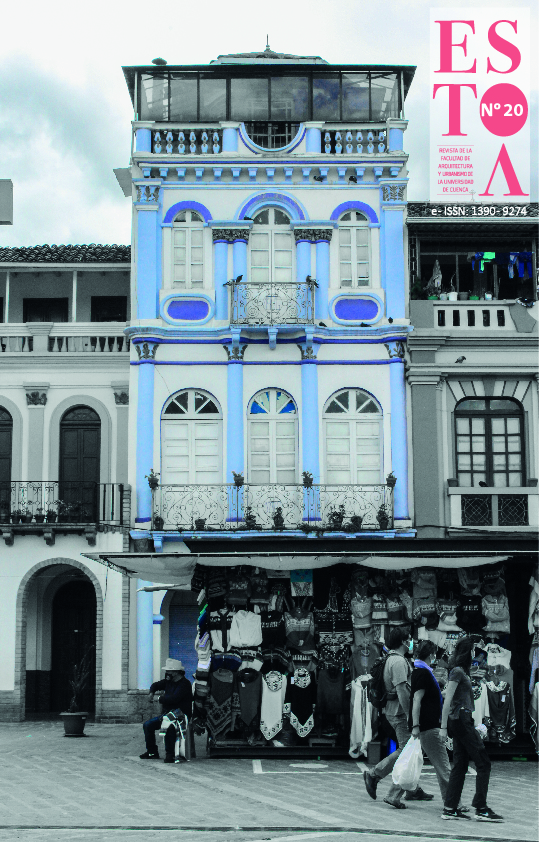Seeking architectures for a healthy city. The stepped sanatorium case study in the twenties
DOI:
https://doi.org/10.18537/est.v010.n020.a01Keywords:
healthy city, social dwelling, sanatorium, stepped architectureAbstract
At the beginning of the 20th century, some doctors and architects focussed their efforts on finding solutions to improve the serious problems of overcrowding and unhealthy living conditions in the industrial cities. For this purpose, they promoted a healthier urban environment and suggested different changes in the architectural design that could define the inner and urban space. To achieve this, one of the most widespread models in the 1920s was the stepped-back architecture. However, despite its importance, few studies have examined the circumstances that made this model an architectural reference for a healthier city and the role-played by certain hospital architecture in promoting those changes. Therefore, the aim of this article is to analyse one of the most outstanding architectural models in this transition: the stepped sanatorium.
Downloads
References
Borie, H. (1865). Aérodômes: essai sur un nouveau mode de maisons d ́habitation. Morris.
Butti, K., y Perlin, J. (1980). Solar Communities of Europe. A Golden Thread: 2500 Years of Solar Architecture and Technology. Van Nostrand Reinhold.
Campbell, M. (2005). What Tuberculosis did for Modernism: The Influence of a Curative Environment on Modernist Design and Architecture. Medical History. 49(4), 463-488. https://doi.org/10.1017/S0025727300009169
Cremnitzer, J. B. (2005). Architecture et santé, le temps du sanatorium en France et en Europe. Picard.
Cremnitzer, J. B., & Toulier, B. (2008). Histoire et Réhabilitation des Sanatoriums en Europe. Docomomo.
Döcker, R. (1929). Terrassentyp: Krankenhaus, Erholungsheim, Hotel, Bürohaus, Einfamilienhaus, Sieglungshaus, Miethaus, und die Stadt. Wedekind.
Duarte, I. (2005). Sanatorios para tuberculosis: auge y decadencia. Ars. Médica, Revista de Estudios Médicos Humanísticos, 34(2), 203-218. https://doi.org/10.11565/arsmed.v34i2.216
Faust, B. C. (1829). Andeutungen über das Bauen der Häuser und Städte zur Sonne. Hahn’sche Hofbuchhandlung.
Fonds Auguste Rollier. (1930). Solarium de Le Frênes en Leysin, 1911. [Fotografía]. Les dents du Midi. https://lesdentsdumidi.ch.
Frampton, K. (2002). Le Corbusier. Akal.
Garnier, T. (1917). Une cité industrielle. Étude pour la construction des villes. Auguste Vincent.
Gescheit, H. (1929). Neuzeitliche Hotels und Krankenhäuser; ausgeführte Bauten und Entwürfe. Ernst Pollak Verlag.
Giedion, S. (1929). Befreites Wohnen. Licht, Luft, Öffnung. Orell Füssli.
Godin, J. B. (1871). Solutions Sociales. Le Chevalier Editeur.
Grober, J. (1932). Das deutsche Krankenhaus: Handbuch für Bau, Einrichtung und Betrieb der Krankenanstalten. Gustav Fischer.
Hénard, E. (1982). Études sur les transformations de Paris, et autres écrits sur l’urbanisme, présentation de Jean-Louis Cohen. L’Équerre.
Howard, E. (1898). To-morrow: A Peaceful Path to Real Reform. Swan Sonnenschein & Co.
Institut für Wohnbau. (2010). Avantgarde der 1960-er in Graz und Wien. [Fotografía] Institut für Wohnbau http://www.iwtugraz.at/iw/mediathek.html
Jiménez, E., y Vargas, I. C. (2017). Hotels and sanatoria: the influence of tuberculosis on mass tourism architecture. Historia ciencia saude- Manguinhos, 24(1), 243-260. https://doi.org/10.1590/s0104-59702017000100006
Knauff, F. (1879). Da neue akademische Krankenhaus in Heidelberg. Bassermann
Le Corbusier. (1927). Où en est l’architecture. L’Architecture Vivante (17-18).
Loyer, F., y Guéné, H. (1987). Henri Sauvage. Les inmeubles a gradins. Mardaga.
Megahed, N. A., & Ghoneim, E. M. (2020). Antivirus-built environment: Lessons learned from covid-19 pandemic. Sustainable Cities and Society, 6. https://doi.org/10.1016/j.scs.2020.102350
Moneo, R. (1965) A vueltas con la Metodología. Revista Arquitectura, 82, 9.
Overy, P. (2008). Light, Air and Openness: Modern Architecture Between the Wars. Thames & Hudson.
Poeschel, E. (1928). Das Flache Dach im Davos. Das Werk, (15), 102-109.
Quintus M. (1992). Le sanatorium: architecture d’un isolement sublime. [Catalogo] https://www.epfl.ch/campus/art-culture/museum-exhibitions/archizoom/le-sanatorium-architecture-dun-isolement-sublime/
Rey, A. A., Pidoux, J., y Barde, C. (1928). La Science des Plans de Villes. Paris. Dunod.
Rollier, A. (1923). Heliotherapy: with special consideration of surgical tuberculosis. Frowde and Hodder & Stoughton.
Sant’elia, A. (1914). Il Manifesto dell’architettura futurista. Rivista Lacerba, 1(15), 167.
Savoire, C. (1902). La lutte antituberculeuse, ses rapports avec l’art de l’architecte, de l’ingénieur et de l’industrie technique . Bulletin de la Société des architectes diplômés par le gouvernement, 3(4), 133-134.
Sarason, D. (23-29 septiembre de 1907). Ein neues Bausystem für Krankenanstalten und Wohnhäuser. Bericht über den XIV. internationalen Kongress für Hygiene und Demographie, Berlín, Alemania.
Sarason, D. (1909). Freilufthäuser. Ein neues Bausystem für Krankenanstalten und Wohngebäude (Prämiert mit der goldenen Medaille der Intern. Tuberkulosekongress in Washington, 1908). Zeitschrift für Krankenanstalten, (12), 280-290.
Sarason, D. (1913). Das Freilufthaus, Ein Neues Bausystem Für Krankenanstalten Und Wohngebäude: Prämiiert Mit Der Goldenen Medaille Vom Internationalen Tuberkulosekongress In Washington 1908. J. F. Lehmann.
Sonne, W. (2009). Dwelling in the metropolis: Reformed urban blocks 1890-1940 as a model for the sustainable compact city. Progress in Planning, 72(2), 53-149.
Sonnier, G. (1977). La Montaña y el Hombre. Editorial R. M.
Studio Chevojon y Sarazin, C. (s.f.). Immeuble d’habitation, rue Vavin, Paris 6e. Vue de la façade sur la rue Vavin. [Fotografía] Fonds Sauvage. Cité de l’architecture et du patrimoine. Institut français d’architecture. http://archiwebture.citechaillot.fr.
Tornikiotis, P. (1999). The historiography of modern architecture. MIT.
Vogt, A. (1879). Über die Richtung der städtischen Straßen nach der Himmelsgegend und das Verhältnis ihrer Breite zur Häuserhöhe. Zeitschrift für Biologie.
Published
How to Cite
Issue
Section
License
Copyright (c) 2021 Estoa. Revista de la Facultad de Arquitectura y Urbanismo

This work is licensed under a Creative Commons Attribution-NonCommercial-ShareAlike 4.0 International License.
The Journal declines any responsibility for possible conflicts derived from the authorship of the works that are published in it.
The University of Cuenca in Ecuador conserves the patrimonial rights (copyright) of the published works and will favor the reuse of the same ones, these can be: copy, use, diffuse, transmit and expose publicly.
Unless otherwise indicated, all contents of the electronic edition are distributed under a Creative Commons Attribution-NonCommercial-ShareAlike 4.0 International License.




